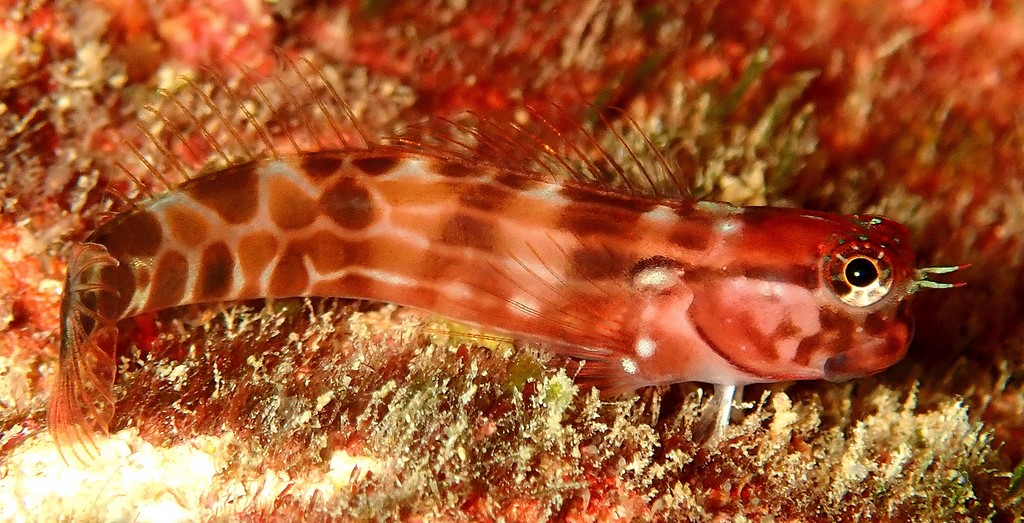ECSENIUS TESSERA - (SPRINGER, 1988)
Picture courtesy of: Alain Daoulas
Actinopterygii (Gigaclass) > Actinopteri (Class) > Teleostei (Subclass) > Blenniiformes (Order) > Blennioidei (Suborder) > Blenniidae (Family) > Salariinae (Subfamily) > Ecsenius (Genus)
Blennie mosaïque, Blenny mosaic, 新喀里多尼亚异齿鳚,
Description
Dorsal spines (total): 12; Dorsal soft rays (total): 14-15, with deep notch between spinous and segmented-ray portions; Anal spines: 2; Anal soft rays: 16-17; Pectoral fin rays: 13; Segmented caudal-fin rays: 13. Vertebrae: 10 + 23; Lateral line without vertical pairs of pores, terminating posteriorly at some point between vertical from interspace between dorsal-fin spines 10 and 11 and vertical from first segmented ray. Dentary incisor teeth: 50-54 which includes anterior canine teeth very similar in appearance with incisors; Posterior canines: 1 on each side. Lateral line without vertical pairs of pores, terminating posteriorly at some point between vertical from interspace between dorsal-fin spines 10 and 11 and vertical from first segmented ray. With cirrus on posterior rim of anterior nostril; Absent on anterior rim. Max. length: 4.5 cm SL. Depth range: 6 - 10 m.
Color
Dorsal,pectoral and caudal fin rays tinged with pink; Anal fin with broad, orange-brown stripe; Brilliant white spot just dorsal to pectoral-fin base, one or two on base, one on caudal peduncle dorsally, and one on caudal fin basally and centrally; Pelvic fins mostly black, with white base and outer margin.
Etymology
Ecsenius: origine uncertain, from Greek, ekseio = shake out or off, or from Greek, exenios, -os, -on = uncontrolled, immoderate.
tessera: from Latin, tessera = small square piece used for making a mosaic. Referring to the tile-like appearance of the color pattern on the body.
Original description: Ecsenius tessera Springer, 1988 - Type locality: outside barrier reef west of Mato Pass, south end of New Caledonia, western Pacific, depth 6-10 meters, J.E. Randall and L. Maugé, 13 January 1979.
Distribution
Western Pacific: New Caledonia and Vanuatu.
Biology
Adults inhabit coral reefs, from clear coastal to outer reef walls, usually where currents are moderate. Oviparous. Eggs are demersal and adhesive, and are attached to the substrate via a filamentous, adhesive pad or pedestal. Larvae are planktonic, often found in shallow, coastal waters.
Actinopterygii (Gigaclass) > Actinopteri (Class) > Teleostei (Subclass) > Blenniiformes (Order) > Blennioidei (Suborder) > Blenniidae (Family) > Salariinae (Subfamily) > Ecsenius (Genus)
Blennie mosaïque, Blenny mosaic, 新喀里多尼亚异齿鳚,
Description
Dorsal spines (total): 12; Dorsal soft rays (total): 14-15, with deep notch between spinous and segmented-ray portions; Anal spines: 2; Anal soft rays: 16-17; Pectoral fin rays: 13; Segmented caudal-fin rays: 13. Vertebrae: 10 + 23; Lateral line without vertical pairs of pores, terminating posteriorly at some point between vertical from interspace between dorsal-fin spines 10 and 11 and vertical from first segmented ray. Dentary incisor teeth: 50-54 which includes anterior canine teeth very similar in appearance with incisors; Posterior canines: 1 on each side. Lateral line without vertical pairs of pores, terminating posteriorly at some point between vertical from interspace between dorsal-fin spines 10 and 11 and vertical from first segmented ray. With cirrus on posterior rim of anterior nostril; Absent on anterior rim. Max. length: 4.5 cm SL. Depth range: 6 - 10 m.
Color
Dorsal,pectoral and caudal fin rays tinged with pink; Anal fin with broad, orange-brown stripe; Brilliant white spot just dorsal to pectoral-fin base, one or two on base, one on caudal peduncle dorsally, and one on caudal fin basally and centrally; Pelvic fins mostly black, with white base and outer margin.
Etymology
Ecsenius: origine uncertain, from Greek, ekseio = shake out or off, or from Greek, exenios, -os, -on = uncontrolled, immoderate.
tessera: from Latin, tessera = small square piece used for making a mosaic. Referring to the tile-like appearance of the color pattern on the body.
Original description: Ecsenius tessera Springer, 1988 - Type locality: outside barrier reef west of Mato Pass, south end of New Caledonia, western Pacific, depth 6-10 meters, J.E. Randall and L. Maugé, 13 January 1979.
Distribution
Western Pacific: New Caledonia and Vanuatu.
Biology
Adults inhabit coral reefs, from clear coastal to outer reef walls, usually where currents are moderate. Oviparous. Eggs are demersal and adhesive, and are attached to the substrate via a filamentous, adhesive pad or pedestal. Larvae are planktonic, often found in shallow, coastal waters.
Last update: 28, March 2022
